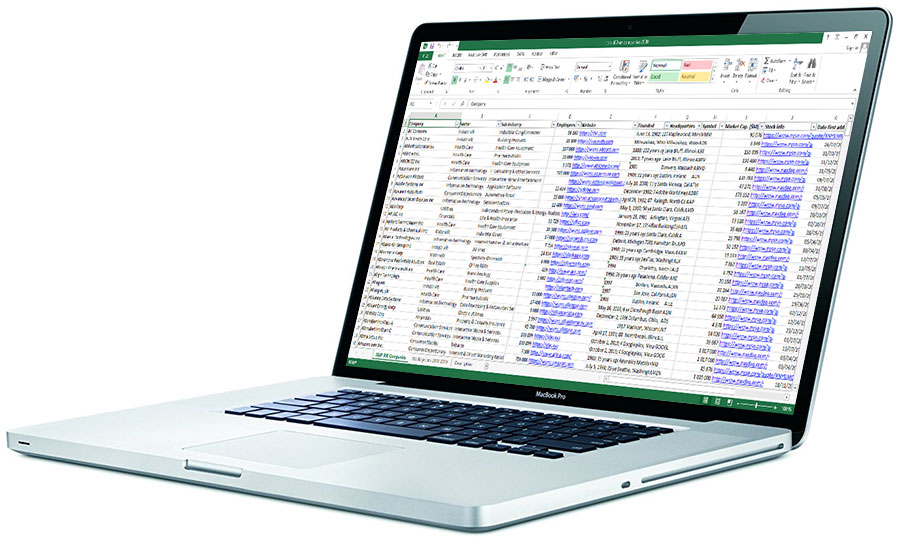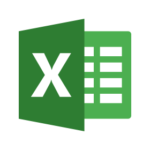Download: All Ordinaries Companies – Excel file with the Top 500 Australian companies data
Browse, filter, and use data easily on the Top 500 companies listed in Australia, constituents of the All Ordinaries index. Get all the information on top companies in key Australian indices: ASX 200, ASX 20, ASX 50, ASX 100, ASX 300, and All Ordinaries.
Download description
This Excel file contains 2 actionable spreadsheets:
1. The main list of All Ordinaries companies Excel spreadsheet contains all the key data on each company. These top 500 largest public listed companies by market capitalization in Australia, constituents of the All Ordinaries Index, are detailed with extensive business, market, financial, and digital information.
This file contains 2021 data. If you are looking for fresher data, there is an updated and expanded version of this file available here.
The entire All Ordinaries companies list, and their related data, can easily be browsed and filtered according to your specific purposes: grouping by sectors/industries/indices, location, ranking by market capitalization, sorting websites, etc.
2. The second spreadsheet includes the stock prices of the entire All Ordinaries index list for 2018, 2019, and 2020. With the prices of all All Ordinaries companies’ stock at the end of each month from December 2017 to December 2020, this second Excel spreadsheet will greatly help you assess the financial health and evolution of each company, providing new opportunities to analyze data, calculate correlations between stocks, estimate seasonality, cross analyze stocks by industry, sector, or even arbitrary batches.
✅ Key benefits from the All Ordinaries Companies Excel Download [Top 500 Australian Companies]
- Quickly browse and filter the companies’ information in a single convenient Excel file for multiple purposes, including:
- corporate benchmarking for marketing, finance, and investment
- searching and filtering companies for informed lead generation
- quickly reaching companies’ websites and online presence in bulk
- using stocks data to perform cross-stocks analysis, statistics, and machine learning for financial and investment insights
- Keep all the information readily available on your computer at any time, even offline.
- Easily use the companies’ data in other applications and programs thanks to a standard Excel file (.xls/.xlsx).
- Save tens of hours of companies’ information search, collection, and formatting in one convenient Excel file.
- Use data to boost your productivity and discover decisive insights, NOW!
Featured Reviews
George Harding – Senior Sales Manager
⭐⭐⭐⭐⭐
![Top 500 Australian Companies [All Ordinaries] – Excel Download sample](https://store.disfold.com/wp-content/uploads/sites/11/2021/04/top-companies-cover-sample.jpg) To let you know exactly what the All Ordinaries Companies spreadsheet contains, you can here download a free sample. This extract of both spreadsheets includes all the data of the first 10 companies, together with the explanatory notes of the description spreadsheet. For more information about each column data, please see below.
To let you know exactly what the All Ordinaries Companies spreadsheet contains, you can here download a free sample. This extract of both spreadsheets includes all the data of the first 10 companies, together with the explanatory notes of the description spreadsheet. For more information about each column data, please see below.
Details of the main All Ordinaries companies list Excel spreadsheet data
Here is a presentation of all the information included in each of the 43 columns of the main All Ordinaries Companies XLS spreadsheet. This detailed data can be sorted and filtered according to each column with a filter button present in the right of the columns’ headings cells.

All data included in the main spreadsheet are updated as of April 2, 2021.
▪ Company
Official company name. Certain companies are included multiple times when they have multiple securities listed on the Australian Securities Exchange and included in key Australian stock indices.
▪ Ticker
Stock ticker of the company. Companies with multiple stocks listed also have multiple, different tickers, one for each kind of stock.
▪ Sector
Main economic sector of the company.
▪ Industry
Main industry of the company.
▪ Country
Country of the main headquarter of the company. Some companies headquartered abroad have stocks listed on the Australian Securities Exchange, and are therefore included in this document.
▪ City
City of the main headquarter of the company.
▪ Province
Province code of the main headquarter of the company, when they are headquartered in Australia, or state or province codes for companies headquartered in the US and Canada.
▪ Website
URL of the company’s main corporate website with a direct link.
▪ Market Cap.
Market capitalization of the company in Australian $ (AUD), as of effective close on Friday, April 2, 2021. Companies with multiple securities quoted may present a discrepancy between their valuation according to each security.
▪ Products & Services
Main products and/or services of the company.
▪ Logo URL
URL with direct link to the logo of the company on Clearbit.
▪ Foundation
Date or year of the foundation of the company, and age of the company, when available. Some companies have more information included on their founding companies, renaming, key mergers, etc.
▪ Founder(s)
Company’s founder(s).
▪ Key People
Leaders of the company with their title.
▪ Employees
Total number of full-time employees in the company.
▪ Social media profile URL with direct links (1 column per network)
▪ Security Name
Name of the listed security of the company. Companies with multiple stocks listed have different security names, usually according to the different classes of stocks available. Each security corresponds to a single ticker previously listed.
▪ Indices (1 column per index)
Key Australian indices in which the stock is included. Multiple stocks from a single company are independent in their integration or not in any stock index, depending on each stock index selection criteria.
- ASX 200: The S&P/ASX 200 index includes the 200 largest companies by market capitalization listed on the Australian Securities Exchange with minimum liquidity requirements. It is generally accepted as the benchmark index of Australian stocks, representing about 80% of the capitalization of the exchange. Last selected by S&P Global on 31 Mar 2021, the 200 companies and stocks included are listed on Market Index AU.
- ASX 20: The S&P/ASX 20 index includes the 20 largest companies by market capitalization listed on the Australian Securities Exchange with minimum liquidity requirements, as last selected by S&P Global on 31 Mar 2021, and listed on Market Index AU.
- ASX 50: The S&P/ASX 50 index includes the 50 largest companies by market capitalization listed on the Australian Securities Exchange with minimum liquidity requirements, as last selected by S&P Global on 31 Mar 2021, and listed on Market Index AU.
- ASX 100: The S&P/ASX 100 index includes the 100 largest companies by market capitalization listed on the Australian Securities Exchange with minimum liquidity requirements, as last selected by S&P Global on 31 Mar 2021, and listed on Market Index AU.
- ASX 300: The S&P/ASX 300 index includes the 300 largest companies by market capitalization listed on the Australian Securities Exchange with minimum liquidity requirements, as last selected by S&P Global on 31 Mar 2021, and listed on Market Index AU.
- All Ordinaries: The All Ordinaries index includes the 500 largest companies by market capitalization listed on the Australian Securities Exchange with minimum liquidity requirements, as last selected by S&P Global on 31 Mar 2021, and listed on Market Index AU.
▪ Stock info
URL of the company’s official security information with direct link to its profile on the Australian Securities Exchange website.
▪ Yahoo Finance profile
URL of the company/security profile on Yahoo Finance with a direct link.
▪ Total assets
Latest figure for total assets of the company recorded on Wikipedia, with the corresponding year.
▪ Total equity
Latest figure for total equity of the company recorded on Wikipedia, with the corresponding year.
▪ Revenue
Latest revenue result of the company recorded on Wikipedia, with the corresponding year.
▪ Operating income
Latest operating income result of the company recorded on Wikipedia, with the corresponding year.
▪ Net income
Latest net income result of the company recorded on Wikipedia, with the corresponding year.
▪ Other Listings (1 column per extra listing)
Other stock exchanges and ticker of the company’s stock when it is also listed outside of the Australian Securities Exchange. Foreign stock exchanges are references with their identifying letters, together with the security’s ticker on this exchange, while over-the-counter securities are listed with OTCQB.
▪ Address, Zip, Phone, Fax (1 per column)
Address of the company, which sometimes includes secondary info in the column “Address (line 2)”, Zip code, Phone number, and Fax number are also mentioned, each in their own column.
▪ Wikipedia URL
URL with direct link to the company’s main page on Wikipedia.
▪ Description
Succinct description of the company’s activities, retrieved from the introduction of the main Wikipedia page of the company.
“N/A” or blank cell: data not available at the time of the creation.
For a complete preview, download the free spreadsheet sample.
Download technical details
 Type: Excel file (.xlsx/.xls)
Type: Excel file (.xlsx/.xls)- Size: 341 Ko
- Spreadsheets: 3
- 1 sheet containing the All Ordinaries Companies 2021 information with filters
- 1 sheet containing the All Ordinaries Companies stock prices at the end of each month for 2018, 2019, and 2020 with filters
- 1 sheet with the detailed description of the data included in the 2 other spreadsheets
- Author/Editor: Disfold
![Top 500 Australian Companies [All Ordinaries] – Excel Download](https://store.disfold.com/wp-content/uploads/sites/11/edd/2021/04/top-500-australian-companies-allordinaries.jpg)




![Top 1200 UK Companies [FTSE All-Share + FTSE AIM All-Share] – Excel Download](http://store.disfold.com/wp-content/uploads/sites/11/2024/05/top-1200-uk-companies-ftseallshare-aimallshare-small.jpg)
![Top 500 Australian Companies [All Ordinaries] – Excel Download](http://store.disfold.com/wp-content/uploads/sites/11/2021/04/top-500-australian-companies-allordinaries-small.jpg)